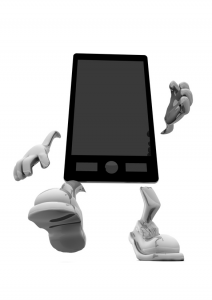 A buddy of mine who was traveling on business last week knew he was going to miss his annual Passover Seder. Not to worry – while he couldn’t be there in real-time, he simply logged on to OurJewishCommunity.org via his iPad and participated with other Jews worldwide in a virtual Seder.
A buddy of mine who was traveling on business last week knew he was going to miss his annual Passover Seder. Not to worry – while he couldn’t be there in real-time, he simply logged on to OurJewishCommunity.org via his iPad and participated with other Jews worldwide in a virtual Seder.
That got me to wonderin’ – how do some of the world’s most popular religions, in effect, ‘market’ themselves? What are some of the digital tools available online and does going the virtual route somewhat detract from physically being in a place of worship or complement someone’s spirituality?
So I spent a bit of time wandering in the digital desert and came across a number of interesting sites and apps. Here’s a snapshot (alphabetized — not listed in any particular order of preference):
Buddhism
Sumi Loundon Kim, the Buddhist chaplain at Duke University and minister for the Buddhist families of Durham, NC, summed up the dilemma of teaching Buddhism to a new generation that uses texting, Facebook, Twitter and other online social media.
“These other worlds exist only through the eyes and mind; there is no touch, no taste, no smell, and very little hearing. As such, virtual worlds present us Buddhist teachers with students who live not just one step removed from reality, but two,” said Kim.
Kim added that Buddhist teachers can’t afford to underestimate the impact of social media on young people today since they have become ‘neurologically adapted’ to this lifestyle.
“The next generation of dharma teachers must not shy away from understanding the force of technology,” she said.
And one of these entities is The Buddhist Channel (www.buddhistchannel.tv). The site’s home page has a pithy slogan on its landing page – ‘Bringing Buddha Dharma Home.’ The Buddhist Channel offers a welter of information and tools – global news related to Buddhism, features on archaeology, arts & culture, healing, travel, various podcasts from Buddhist scholars, even e-cards and games.
Another site, Unfettered Mind was established in 2001 by a Buddhist teacher, Ken McLeod. It provides scores of hours of iTunes podcasts, Buddhist text translations, sutra sessions, and more.
In South Korea, where smartphones are more ubiquitous than in the U.S., there are numerous Buddhist apps ranging from a mobile version of Buddhist prayer beads to a location search program that uses GPS to find the nearest temple. Another app, ‘Hello Dharma School,’ features pop-up animations of the Buddha’s life and uses simple vocabulary to explain basic Buddhist philosophies.
“Modern day people are too busy and don’t have time to visit temples,” said Jung Ho, director of missionary research at the Jogye Order, the biggest Buddhist sect in the country. “With mobile apps, people can keep in touch with Buddhism – smartphones can serve as mobile temples.”
Christianity
Even the pope’s gone digital. The Vatican is using technology to help Pope Benedict XVI reach out to his flock of more than one billion Catholics worldwide. The site has its own multimedia player called Vatican Player that aggregates content from Vatican media (managed by Vatican Radio). On the site you can access the pope’s encyclicals, homilies, read apostolic letters, download info on basilicas and papal chapels, etc.
But in one of his messages, the pope offered a caveat. New media and social networks offer a ‘great opportunity’ but he warned of the risks of having more virtual friends than real ones.
“It is important always to remember that virtual contact cannot and must not take the place of direct human contact with people at every level of our lives,” said the pope.
Another thriving Christian online site is GodTube.com, which is now drawing over two million monthly users. CEO Chris Wyatt recently said “we apply web technology to the Gospel in a way that appeals to young people – we call it Jesus 2.0.”
Chris Ford, a social media expert with the Southern Baptist Convention, said social media is a big plus for Christianity and has had an overall positive impact in three areas – evangelism, ministry outreach, and educational communications.
“It should be no surprise that, for spreading the Gospel and globally mobilizing people for missions, social media also can have significant, positive implications,” said Ford.
Brandon Vogt, a Catholic writer/speaker who also blogs at ThinVeil.net, said that at its core, the church is ‘one giant social network.’ Church fellowship, noted Vogt, shouldn’t be exclusive and closed in on itself – it should always be outward-focused and mission-oriented.
“Fellowship in the past was constrained to times when people gathered at churches or in homes, but now conversations about Sunday sermons can linger throughout the week,” said Vogt.
Vogt added that social media also opens the doors of Christian fellowship, inviting millions of outsiders to join the community.
“Young secularists who would never darken the doors of a church find themselves dialoguing with Christian bloggers, and an atheist YouTube viewer stumbles across a religious debate and becomes intrigued by the idea of God…when used prudently, social media tightens the bonds among Christians and also connects them with millions outside the faith,” said Vogt.
Hinduism
Hinduism, the world’s third largest religion after Christianity and Islam, has about 950 million followers. It’s the dominant religion in India, Nepal and among the Tamils in Sri Lanka.
Hindu Online purports to be the world’s largest portal on Hindu religion, culture, shastras, and more. There’s a vast array of information available on the site – scores of articles, sections devoted to religion, culture, community, a digital library featuring manuscripts (e.g., Veda, Upanishads, Ayurveda), even a Learn Online area where you can get up to speed on everything from Sanskrit to Vedic mathematics.
Two more interesting examples:
Kauai’s Hindu Monastery, located in Kapaa, HI, is a monastery-temple complex with 21 monks. Established in 1949, the monastery has a very popular Facebook page – at last count almost 4,200 had ‘Liked’ it. The Facebook page features photos and videos of the temple, and site visitors share their thoughts and experiences on the monastery’s Wall. Lastly, the site provides links to other Hindu organizations such as the Hindu Students Association, Hinduism Today Magazine and Hindu American Foundation.
Twitter is also being used more frequently for major religious holidays.
Diwali, India’s biggest and most important holiday of the year, is celebrated in October or November each year and is also known as the Festival of Light. Run a search that time of year and you’ll find that #HappyDiwali will be trending.
One popular Tweet last year came from Bollywood actress Kareena Kapoor:
“A very happy Diwali to all of our followers! Spend some quality time with family and friends and be safe!”
Popular Hindu leaders have jumped on the Twitter bandwagon to reach out to their followers. Devotees of Mata Amritanandamayi, a spiritual leader and guru who is sometimes referred to as ‘The Hugging Saint,’ regularly tweets (@amritapuri) in order to provide real-time updates of her activities.
Islam
It has been well documented how social media helped usher in last year’s ‘Arab Spring.’ But technology is also playing an important role in reaching out to Muslims worldwide on religious matters/issues.
For starters, there have been a suite of apps developed for smartphones that have become popular during Ramadan, the ninth month on the Islamic calendar. Ramadan generally lasts about 30 days; participating Muslims refrain from drinking, eating, smoking and sex during daylight hours. Other apps help find the nearest mosque or halal (food that’s permissible per Islamic law) restaurants in various cities.
Some examples:
iQuran, an Android app on Google Play, enables viewers to read the Holy Quran in Arabic alongside its translation. It provides verse-by-verse audio playbacks, repeat functions and unlimited bookmarks.
The Essentials of Ramadan, available on iTunes, provides in-depth info on the rules and laws of Ramadan.
Find Mecca, also on iTunes, uses GPS to locate the Qibla (the direction that should be faced when a Muslim prays; it’s fixed as the direction of the Kaaba in Mecca) anywhere worldwide using an iPhone or iPad. Users can see Mecca with the camera in augmented reality mode; the app also can set an automatic countdown to the next required prayer and adjusts to various time zones.
Nidhal Guessoum, reporting in The Huffington Post, said Twitter is now being used frequently to send Quranic verses and religious injunctions; YouTube and Facebook to disseminate sermons.
Iran’s Supreme Leader, Ayatollah Khamanei, even issued a fatwa (a juristic ruling issued by an Islamic scholar) on using Facebook:
“In general if it requires engaging in immorality and evil acts such as spreading corruption, lies and false materials, or if there is concern that it is sinful, or it strengthens the enemies of Islam and Muslims, it is not permissible. Otherwise it’s fine.”
Judaism
There are about 13.4 million Jews worldwide, about 0.2% of the world’s population, with about half in Israel, half in the United States. The rest are scattered widely.
One rabbi in the U.S. has taken proactive steps to bridge this diaspora.
Rabbi Laura Baum founded OurJewishCommunity.org – catchphrase under the Welcome sign on the landing page reads ‘Bringing Judaism to People Where They Are.’
The site’s chief objective is ‘to provide the same services of a brick-and-mortar congregation, such as access to rabbis, sermons, educational materials, social networking, discussions, and more.’
OurJewishCommunity.org uses a variety of tools to generate live content – live stream, blogs, video casts on YouTube, audio podcasts on iTunes, a Facebook Fan Page (currently more than 5,200 fans from 18 countries) and a Twitter feed.
Baum recently presided over an online Passover Seder, which attracted over 400 people – but no Orthodox Jews, who are not allowed to use electronic devices during the Seder or Sabbath (Friday night through Saturday sunset).
“Sitting in a room is a powerful way to have community; but the fact you can do Passover with people all over the world, that is not any less of a community,” said Baum.
There are also a number of interesting mobile apps being used by Jews around the world.
The Orthodox Union recently released a new mobile app that provides information on what food products are kosher for Passover.
Crowded Road, a software firm, rolled out iTorah-iPad Edition, which even includes vowels for Hebrew text to make it easier to read.
Davka Corporation, which bills itself as ‘First in Judaic Software,’ offers the Tanach Bible, a Study Tool for the iPhone, iPod Touch and iPad. It includes the Hebrew text and English translation of the Torah and other important works, and can be downloaded on iTunes for $1.99.
Can social media glean modern day solutions to the challenges that first arose during biblical times and are still with us thousands of years later?
Jury’s still out.
But these digital tools are having a significant impact on the social and religious lives of people of all faiths and denominations.
 – there were more than two dozen innovations submitted from the U.S., China, Hungary, Japan, Singapore, and other nations worldwide.
– there were more than two dozen innovations submitted from the U.S., China, Hungary, Japan, Singapore, and other nations worldwide. 








